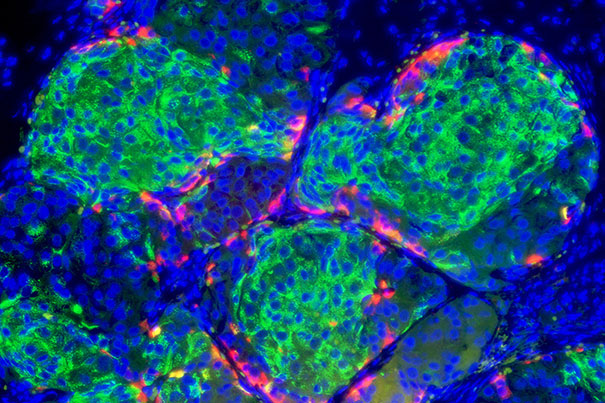human embryonic stem cell
Stem Cell Research: New Recipes for Regenerative Medicine
Posted on by Dr. Francis Collins

Caption: From stem cells to bone. Human bone cell progenitors, derived from stem cells, were injected under the skin of mice and formed mineralized structures containing cartilage (1-2) and bone (3).
Credit: Loh KM and Chen A et al., 2016
To help people suffering from a wide array of injuries and degenerative diseases, scientists and bioengineers have long dreamed of creating new joints and organs using human stem cells. A major hurdle on the path to achieving this dream has been finding ways to steer stem cells into differentiating into all of the various types of cells needed to build these replacement parts in a fast, efficient manner.
Now, an NIH-funded team of researchers has reported important progress on this front. The researchers have identified for the first time the precise biochemical signals needed to spur human embryonic stem cells to produce 12 key types of cells, and to do so rapidly. With these biochemical “recipes” in hand, researchers say they should be able to generate pure populations of replacement cells in a matter of days, rather than the weeks or even months it currently takes. In fact, they have already demonstrated that their high-efficiency approach can be used to produce potentially therapeutic amounts of human bone, cartilage, and heart tissue within a very short time frame.
Stem Cell Science: Taking Aim at Type 1 Diabetes
Posted on by Dr. Francis Collins

Caption: Insulin-producing pancreatic beta cells (green) derived from human embryonic stem cells that have formed islet-like clusters in a mouse. The red cells are producing another metabolic hormone, glucagon, that regulates blood glucose levels. Blue indicates cell nuclei.
Credit: Photo by B. D. Colen/Harvard Staff; Image courtesy of Doug Melton
For most of the estimated 1 to 3 million Americans living with type 1 diabetes, every day brings multiple fingerpricks to manage their blood glucose levels with replacement insulin [1,2]. The reason is that their own immune systems have somehow engaged in friendly fire on small, but vital, clusters of cells in the pancreas known as the islets—which harbor the so-called “beta cells” that make insulin. So, it’s no surprise that researchers seeking ways to help people with type 1 diabetes have spent decades trying a find a reliable way to replace these islets.
Islet replacement has proven to be an extremely difficult research challenge for a variety of reasons, but exciting opportunities are now on the horizon. Notably, a team of researchers, led by Douglas Melton of Harvard University, Cambridge, MA, and partially funded by NIH, reported groundbreaking success just last week in spurring a human embryonic stem cell (hESC) line and two human-induced pluripotent stem (iPS) cell lines to differentiate into the crucial, insulin-producing beta cells. Not only did cells generated from all three of these lines look like human pancreatic beta cells, they functioned like bona fide, glucose-responsive beta cells in a mouse model of type 1 diabetes [3].
